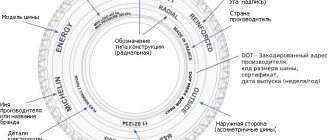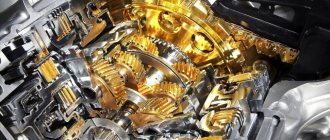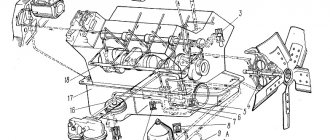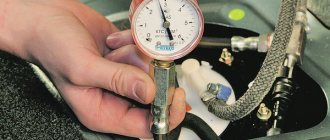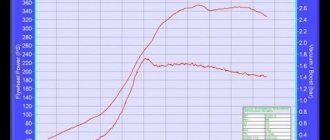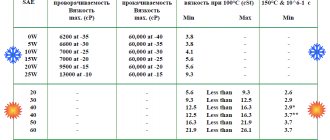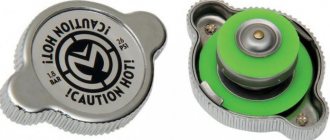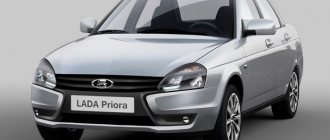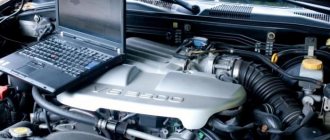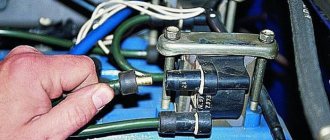How to find out the correct tire pressure for your car?
Instructional materials for each car model contain a number of important parameters that must be observed for safe operation of the vehicle. Among them is the tire pressure value. It may vary depending on the tire size and season. The specified value must be observed, avoiding significant deviations (more than 10%).
Optimal pressure not only contributes to safe movement, but also makes driving more comfortable. If the correct values are observed, the tread is in full contact with the road surface, providing maximum traction. At the same time, the car handles well, clearly responds to all driver actions, and is stable when cornering.
To determine the optimal tire pressure for a particular model, the automaker conducts extensive tests and engineers carry out complex calculations. In this case, the values are determined separately for the cold and hot seasons. This is because air pressure changes depending on temperature. The specific value of the parameter is influenced by the following factors:
- wheel diameter;
- axle weight distribution;
- total weight of the vehicle and its carrying capacity;
- tire type according to the time of year.
You can find out the correct tire pressure for your vehicle in your owner's manual. Also, this parameter is usually indicated on special plates, which can be found either in the front door opening on the driver’s side or on the fuel tank hatch.
Data for the front and rear wheels are indicated separately. If in the future the car owner makes design changes to his car that affect the above factors, the pressure value will need to be adjusted.
It must be taken into account that during the operation of the vehicle the pressure value changes. For example, when a tire heats up, the air expands and the pressure increases . Therefore, when driving at high speeds and sharp braking, the effect of overinflated tires occurs. When calculating the correct pressure value, the manufacturer takes into account various driving modes. And the car owner must independently adjust the pressure depending on specific situations.
When driving on soft ground, it is recommended to lower the tire slightly to ensure better contact between the tread and the road surface. The next time you drive onto hard surfaces, you need to re-inflate the tire to the required level. If you plan to load the vehicle as much as possible, you will need to inflate the wheel to the level recommended by the manufacturer for such situations.
How to measure it correctly
To measure tire pressure, a special device called a tire pressure gauge is used. It can be either mechanical or electronic, be a separate device or be included with the compressor, but its function remains the same - an accurate measurement of the pressure created in the car wheel.
It goes without saying that a pressure gauge, like any mechanism for precise measurements, has its own error. Its value is indicated on the body of the device, and the smaller it is, the more accurate the measurement made by the driver will be. At the same time, the car manufacturer also indicates the recommended tire pressure for a particular vehicle in the accompanying documentation. Many tire manufacturers also provide their own recommendations.
At first glance, everything is simple - the driver just needs to bring the tire pressure in line with the factory recommendations and maintain it at a given level. However, here we return to the fact that pressure is influenced by a number of factors, and the main one is temperature.
Video - what incorrect pressure in car tires can lead to:
In practice, this means that by inflating the wheels to the standard value in the warm season (for a passenger car it varies, depending on the mass, from 2 to 2.5 atmospheres), when the temperature drops, we will get a pressure that is significantly lower. It is especially problematic to “catch” the correct pressure if the car is stored in a warm garage. As a result, the wheels, initially inflated to the correct value, will change their physical properties during the trip, and when entering a heated box, the pressure will return to normal.
A solution to this problem can be the option when the tires are inflated after the car has been parked for a long time in the open air, or compensatory pumping of the tire in a box. However, the question arises of how much the tire should be overinflated in order for the tire pressure to be within the recommended range in winter. Let's try to analyze this situation using the examples of VAZ cars, which, as you know, have wheel diameters of R13 or R14.
What are the dangers of driving on improperly inflated tires?
Many novice motorists have the misconception that an overinflated tire is preferable to an underinflated one. An argument for this can be that on hypercars the tire pressure is usually higher than normal. In fact, any pressure deviation from normal values has an equally negative effect on the tires. Thus, with insufficient pressure, the contact area of the tread with the road surface increases, which causes greater wear at the edges.
Insufficient tire pressure is indicated by:
- increased fuel consumption by 10-20%;
- cornering with great effort;
- the car moves to the side when driving at speeds above 50 km/h.
When the normal pressure value is exceeded, the tread has a smaller contact area with the blade, therefore increased wear is observed in the center. Tire pressure that is too high is indicated by:
- loss of control when cornering;
- car jumps at speeds above 60 km/h (if the wheel hits a pothole or runs over a rock, the tire may be damaged);
- suspension operation in overloaded mode;
- increased noise in the cabin.
When the vehicle is at maximum load, do not over-inflate the wheels. Some car enthusiasts do this, mistakenly believing that the load needs to be compensated by pumping.
The error message “Check tire pressure” appears on the panel - what should I do?
This indicator should not light up if the tire pressure readings are normal. First, you should check the actual pressure level. But there are some secrets of motorists that will help you reset this parameter if it lights up by mistake:
- Using a wrench, try disconnecting the battery and then reconnecting it.
- It is necessary to change the indicators in the wheels: deflate them and then pump them up again.
- You can reset this indicator using the TPMS button without using additional tools.
- You need to drive 15-20 km at a speed of 70-80 km/h.
If after these procedures the sensor does not reset to zero and continues to light, you should contact a technical service center.
Adjusting tire pressure is an important indicator of the normal operation of any vehicle. The owner of the car who monitors the technical condition of the car. And he cares about the safety of himself and his passengers, and will always monitor the atmosphere in the tires.
To do this, you must purchase a pressure gauge and a set of primary tools. It is worth remembering that tire pressure is directly related to weather conditions and has its own seasonal characteristics.
Pressure units
bar (atm)
In European countries and the former Soviet Union, bars (bar) or atmospheres (atm) are used to measure tire pressure. It is indicated in kgf/cm2. The measurement is carried out with a pressure gauge. The error of this device is approximately 1-2%. In fact, bars are somewhat different from atmospheres, the formula looks like this:
bar = 0.980655 x atm
Usually this minor difference is neglected.
kPa
If you see an inscription in kilopascals on your tire, then we are not talking about the recommended value of pressure in the wheel, but about the maximum permissible. The text on the sidewall will look like this: max pressure and then the value in numbers.
This value is translated into familiar atmospheres or bars using the following formula:
bar = kPa / 101.325
To convert bars or atmospheres to kilopascals you need to use the following formula:
kPa = bar x 101.325
convert kPa to psi:
psi = kPa / 6.89476
To convert psi to kilopascals you need to apply this formula:
kPa = psi x 6.89476
psi
The USA uses its own system - psi. It is based on the units used here - pounds and inches. That is, the pressure value is indicated as psi.
psi = bar x 14.706
bar (atm) = psi x 0.068
Examples
1. Let's say your car has a recommended tire pressure of 33 psi. Let's determine how much is this in atmospheres?
atm = psi x 0.068 = 33 x 0.068 = 2.244
That is approximately 2.2 atm (or bar).
2. Let your tire say “Max pressure 400 kPa”. To convert into our usual values, we use the following equation:
bar (atm) = kPa / 101.325 = 400 / 101.325 = 3.9476
That is, approximately 4 “kilograms”, 4 atm (or bar).
To convert from the European standard to the American standard and to kPa, you can use the following table:
| Converting pressure from atmospheres (atm) and bars (bar) to psi and kilopascals (kPa) | ||
| psi | atm (bar) | kPa |
| 20 | 1.36 | 137.895 |
| 21 | 1.428 | 144.790 |
| 22 | 1.496 | 151.685 |
| 23 | 1.564 | 158.579 |
| 24 | 1.632 | 165.474 |
| 25 | 1.7 | 172.369 |
| 26 | 1,768 | 179.264 |
| 27 | 1.836 | 186.159 |
| 28 | 1.904 | 193.053 |
| 29 | 1.972 | 199.948 |
| 30 | 2.04 | 206.842 |
| 31 | 2.108 | 213.738 |
| 32 | 2.176 | 220.632 |
| 33 | 2.244 | 227.527 |
| 34 | 2.312 | 234.422 |
| 35 | 2.38 | 241.317 |
| 36 | 2.448 | 248.211 |
| 37 | 2.516 | 255.106 |
| 38 | 2,584 | 262.001 |
| 39 | 2.652 | 268.896 |
| 40 | 2.72 | 275.79 |
| 41 | 2.788 | 282.685 |
| 42 | 2.856 | 289.58 |
| 43 | 2.924 | 296.475 |
| 44 | 2.992 | 303.369 |
| 45 | 3.06 | 310.264 |
| 46 | 3.128 | 317.159 |
| 47 | 3.196 | 324.054 |
| 48 | 3.264 | 330.948 |
| 49 | 3.332 | 337.843 |
| 50 | 3.4 | 344.738 |
| 51 | 3.468 | 351.633 |
| 52 | 3.536 | 358.528 |
| 53 | 3.604 | 365.422 |
| 54 | 3.672 | 372.317 |
| 55 | 3.74 | 379.212 |
| 56 | 3.808 | 386.107 |
| 57 | 3.876 | 393.001 |
| 58 | 3.944 | 399.896 |
| 59 | 4.012 | 406.791 |
If the air temperature drops to values less than +10°C, then the tire pressure drops by about 10%. In hot weather, the parameter, on the contrary, increases by the same amount. Therefore, this feature must be taken into account when taking measurements in winter and summer.
How to inflate a tire with your own hands
Inflating a car tire is not difficult, but a beginner may have a few questions. Let's look at the stages of the process, and in the end you will know how to properly inflate a tire. To work, you will need a pump, you can use a foot pump, or a compressor. Now there are compressors that operate from a cigarette lighter. If the pump does not have a pressure gauge, this device will also be needed.
Let's take a step-by-step look at how a tubeless tire is inflated.
- We put the car on the handbrake. It is advisable to choose a level place.
- We take out the pump and pressure gauge. If the compressor is electric, connect it to power. Usually the connection occurs through the cigarette lighter; we simply insert the tip of the cord into the cigarette lighter.
- Unscrew the protective cap from the tire nipple. The cap must be placed carefully to the side so as not to be lost.
- Connect the hose tip to the wheel. To do this, the tip is simply put on the nipple, at the beginning you will hear the sound of air escaping. This is fine. Push the tip in completely.
- Then turn the handle of the tip at an angle of 90°. This way we will secure the hose to the nipple.
- We look at the pressure gauge. It shows the tire pressure if we turn on the compressor insufficiently. We wait until the pressure gauge shows a normal parameter.
- Disconnect the tip. This must be done carefully, but quickly enough.
- Screw on the previously removed cap.
Next, we repeat all the described procedures on the remaining wheels, including the spare one. Now the car is ready to go.
If the pump is foot-operated, all actions are similar, except for connecting to power. The air supply is carried out by driving the pump piston, this is done with the foot.
Inflating a car tire is not a difficult job. Every car owner can do this, even without any experience. The main thing is to know the basic rules, they are simple, and it won’t be difficult to follow them. But you will save time on a trip to a car service center.
Why are the pressure values different for different axes?
Among specialists, such a concept as weight distribution along the axes is common. Its essence lies in the fact that due to the design features, the mass of the car is distributed unevenly along the axes.
Weight distribution along axes
Weight distribution differs for different car brands. For example, the VAZ 2108 is characterized by the following parameters:
- unloaded vehicle weight - 927 kg;
- front axle load - 565 kg (61%);
- load on the rear axle - 362 kg (39%).
The weight distribution for other models will be slightly different - see the weight distribution for almost a thousand European, American, Japanese and Korean cars in the file:
| Weight distribution along the car axes, almost 1000 models from European, American, Korean and Japanese manufacturers. Download the pdf file, 1.67MB (click on the icon). |
Since the front axle is usually loaded more than the rear, the wheels in front need to be inflated a little more. What tire pressure should be on the front and rear axles is determined by the car manufacturers themselves. These indicators can be found in the table below.
How to determine incorrect pressure
A cheat sheet from the manufacturer indicates the pressure on cold tires of a car that has been standing motionless for more than 5 hours. In most cases, several sizes can be installed on a machine. It even happens that the front and rear axles have wheels of different widths, which affects the pressure in the car’s wheels. It directly depends on the tire format, but the loads it will have to withstand and the ambient temperature also matter.
What are the consequences of deviation from the norm?
Low pressure in passenger car tires leads to cord deformation and heating of the rubber as the wheel rolls. At the same time, the middle of the tread practically does not touch the road, as a result of which the wear of the tracks in the outer zones accelerates. In such a situation, the integrity of the frame is certainly compromised: how quickly this happens depends on how long the car moves on a poorly inflated wheel. It’s not just the tire that deteriorates; the slightest bump in the road will also cause damage to the disc. Plus, fuel consumption also increases.
Correct and incorrect tire pressure
With increased pressure, on the contrary, only the central part of the tread works (and naturally wears out more), and the sides do not touch the road, since they are bursting with air. On an uneven road surface, people in the car will feel every bump, and if they hit a hole, the tire may simply burst.
Note: The worst thing is when the tire pressure, which is usually denoted in atmospheres, is separated on all 4 wheels. The side of the car where it is lower constantly pulls to the side when driving, which not only irritates the driver, but also creates the preconditions for an accident.
When to check
Knowing what the tire pressure should be, try to check it in a timely manner. Tube tires require weekly inspection. They are rare in passenger vehicles today, but in winter, at low temperatures and on tubeless vehicles, many people install cameras. Tubeless tires are checked less frequently - once a month. But if you have a long road ahead, you should definitely check how much pressure should be in the tires, and if necessary, pump them up.
Inflating a wheel at a tire shop
How does pressure depend on temperature?
Air tends to expand when heated. Accordingly, in a confined space its pressure increases. If the wheels of a car parked in a cool garage are inflated to 2.3 atm, when driving outside where the air temperature is much higher (for example, not +22, but +31), the pressure in them will increase slightly.
- In the summer, the asphalt gets very hot, and in contact with it, as well as due to the impact of friction during movement, the tires also heat up. The higher the temperature difference, the stronger the heating.
- For every 10 degrees, approximately 0.1 atm of pressure is added. In winter, the air, on the contrary, is compressed, resulting in a loss of tire pressure. The manufacturer indicates how many atmospheres to pump the wheels at above-zero temperatures. In winter, it is recommended to pump harder - but not more than 0.3 atm from the norm.
- At this time of year, after a seasonal change of tires, the pressure must be constantly monitored: when moving from plus to minus, when the air temperature sharply drops by 10 degrees or more. Closer to spring, when the frosts weaken, the pressure can no longer be checked until the tires are changed to summer ones.
From April to August, when temperatures are always positive, it is necessary to check the degree of tire inflation mainly either before a long trip, or if it is necessary to transport luggage with a full complement of passengers. In both cases, it is recommended to increase the pressure on the rear tires by 0.2 or 0.3 atm.
What tire pressure should be in summer and winter?
In cold weather conditions, additional tire inflation is required. This is due to the fact that at sub-zero temperatures the air compresses. Accordingly, the wheel will be underinflated. Therefore, in winter, it is necessary to inflate the tire, bringing the indicator to the value recommended by the manufacturer. Usually it is enough to increase the pressure by 0.2-0.3 atmospheres.
It is necessary to slightly increase the tire pressure even when the car is fully loaded. It is enough to increase it by 0.1 atmospheres. You should not over-inflate the wheel; this will not improve the car's handling in any way.
Summary data on tire pressure in winter and summer are presented in the table:
Swamp walker
A specific example of the effect of pressure on patency.
In this case, the pressure is very low, and the contact patch of the wheel with the coating is much larger than that of a conventional car. A specific example of the effect of pressure on patency. In this case, the pressure is very low, and the contact patch of the wheel with the coating is much larger than that of a conventional car.
In general, it is better to keep the pressure in tires, as well as in blood vessels, at normal levels. Any deviations have their negative consequences. Tell us, have you had to adjust the tire pressure to improve cross-country ability?
Tire pressure: your norm
How to monitor tire pressure?
Most modern models are equipped with their own tire pressure monitoring system - TPMS. Different manufacturers have implemented it in different ways, but in general the principle comes down to the fact that the sensors read information, which is then displayed on the display.
If you have an older model, then you need to monitor the pressure yourself. Typically, a pressure gauge connected to the wheel is used for this. There is another way - for those who do not want to constantly manipulate the pressure gauge. It consists of using special caps that are installed on the nipples.
The caps that control the pressure will not show its exact value, but they will indicate a deviation from the norm. The caps have an indicator whose green color indicates normal tire pressure. Yellow color indicates that the parameter is 0.3 bar below normal, therefore it is recommended to pump up the wheel. And the red color will indicate that the pressure has dropped by 0.7 bar, which means that further driving becomes dangerous, and you urgently need to re-inflate the tire.
To know what pressure should be in the tires on your car, you should be guided solely by the manufacturer’s recommendations. Even for the same model, depending on the configuration, normal values may differ.
How much tire pressure should be: tips just in case
Situations on the road are different, and you can get out of some with honor by relieving the pressure from the tires. Let's look at some of them:
- A situation that you wouldn’t wish on your enemy is when a driver on summer tires is caught in ice: they went out of town for an overnight stay, were on a fishing trip or on a business trip. The task of survival in this case becomes the need to drive on an icy surface - to the house, garage or store where winter tires are sold.
- Reducing the tire pressure to 1.6 atm will help make the “slippery slope” possible. Most often, this figure is already critical, but half-flat tires in this situation will protect the car from an accident. Such driving may damage the tires, but at low speed they will not heat up, and if you drive close, you can only get away with a slight fright.
- If the car does not have all-wheel drive, even if it has the “correct” wheels, it can skid in the snow in the winter, and in sand or mud in the summer - you never know where and for what reasons you may have skidded. To get onto a hard surface, you can also relieve the pressure from the tires. Moreover, it is necessary to reduce it to 1.2 atm not only on the drive wheels, but also on the driven ones. And if the rims have tires that are wide enough and can self-dismount if they slip, the pressure can be reduced to 1 atm.
The same must be done when slipping on wet grass. Pressure relief can also work in a situation where the car finds itself with diagonally hung wheels (when one wheel on each axle is hanging in the air). If you reduce the air filling of the wheels on which the car rests, their height will decrease, which will allow the suspended wheels to stand on the road. True, if the car is lying on the bottom, such actions will be useless.
Recommendations for choosing pressure
If you purchase not stock, but more expensive tires that are perfect for the driver’s driving style, then you should ask a consultant what pressure range can be used for the tire. Typically, manufacturers indicate markings on the side of the tire. When operating, you must adhere to the recommendations not of the car manufacturer, but to the values indicated on the tires.
The optimally selected pressure will ensure correct and comfortable use of the machine. If the driver is going on a long trip on asphalt, then it is better for him to set the maximum value that the tire allows. This manipulation will reduce fuel consumption, improve handling and vehicle dynamics.
On a note! If the car will drive on dirt or sandy roads, the pressure must be reduced to the minimum acceptable level, which allows you to increase the contact patch and reduce the severity of the reaction.
Many SUVs and wheeled military vehicles are equipped with manual pressure control, which helps improve cross-country ability on unpaved roads.
When using a car in urban conditions, it is necessary to set the average acceptable value. It is important to measure it at least once a week using a manual pressure gauge. Some modern cars are equipped with an ECU with a built-in sensor in the spool. When the indicator changes, the corresponding information is displayed on the instrument panel. Measurements can only be taken when the rubber is cold.
Owners of cars with low-profile tires are advised to avoid low tire pressure, since getting into even a small hole in the road at speed can result in a “hernia,” a wheel rupture, and even a bent disc.

